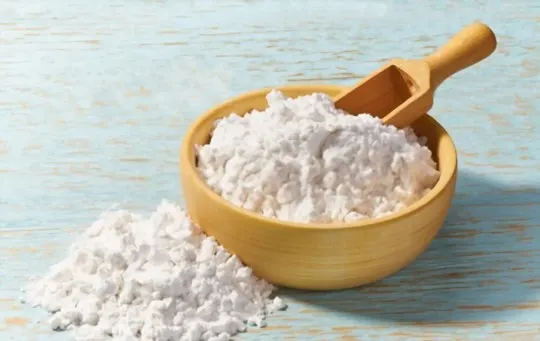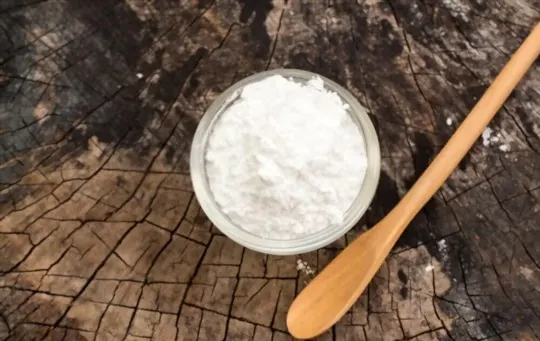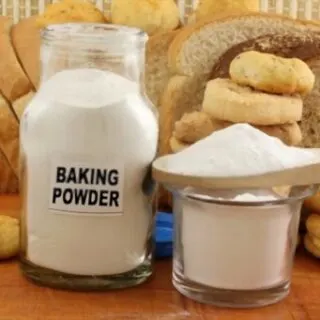Have you ever wondered what baking powder tastes like? If so, you are not alone.
Many people find the idea perplexing since baking powder is an ingredient added into your favorite recipes for a leavening agent.
Although it’s usually disguised through flavors of other components in the dish, seeking to learn more about its unique taste can give your cooking and baking journey a sense of direction.
In this comprehensive guide, we’ll explore everything you need to know about the flavor of baking powder – including how (if at all) it impacts whatever got mixed with it!
Ready to dive in?
So sit tight, grab that cup of coffee or tea, because this promises to be an interesting read!
What is Baking Powder?

Baking powder is an essential ingredient in the baking world, and if you’ve ever baked a cake or made some cookies, chances are high that you’ve used it.
Baking powder is a dry chemical leavening agent used to help baked goods rise, resulting in a light and fluffy texture.
It’s a combination of a base, an acid, and a filler, which creates a chemical reaction when it comes in contact with moisture and heat.
This reaction produces carbon dioxide gas, which causes the baked goods to rise.
The use of baking powder saves time and effort compared to traditional methods of leavening, which require yeast and need time to rise.
Besides ease of use, baking powder is versatile and can be used in a wide range of baked goods like muffins, pancakes, and bread, making it an essential ingredient in your pantry.
Now you know why baking powder is the secret to your fluffy, perfectly risen baked goodies.
What Does Baking Powder Taste Like?

Baking powder is a leavening agent used in baking to help batter rise and achieve a fluffy texture.
Unlike baking soda, it does not have a strong taste and is primarily used to create a chemical reaction when combined with acidic ingredients.
The taste of baking powder is slightly metallic and acidic due to its combination of cream of tartar, sodium bicarbonate, and cornstarch.
However, the taste is not typically noticeable in small quantities and is often outweighed by the flavors of other ingredients in baked goods.
Pro tip: To avoid a metallic taste in your baked goods, use a high-quality, aluminum-free baking powder and only use the amount called for in the recipe.
Why Does Baking Powder Taste Bitter?
Baking powder is a common leavening agent used in baking to help baked goods rise.
It is a blend of baking soda, cream of tartar, and a moisture-absorbing agent like cornstarch.
Baking powder has a neutral taste, but sometimes it can taste slightly bitter if it contains an excess amount of baking soda.
This can happen if the baking powder is old or has been exposed to moisture, causing the acid in it to lose its potency.
To determine if your baking powder has gone bad, you can do a simple test.
Mix some baking powder with hot water, and if it fizzles, it is still good.
If it doesn’t, it’s time to replace it.
To avoid a bitter taste in your baked goods, make sure to measure your baking powder accurately and store it in an airtight container in a cool, dry place.
Pro tip – Add a pinch of salt to your baking powder mix to neutralize any potential bitterness.
How to Use Baking Powder in Cooking and Baking?

Baking powder is a leavening agent used in cooking and baking to help products rise and become light and fluffy.
It is a combination of baking soda, an acid (usually cream of tartar), and a starch (usually cornstarch) to keep the mixture dry.
Unlike baking soda, which has a metallic, salty taste, baking powder is tasteless and odorless, making it an ideal ingredient for baked goods where you don’t want its flavor to overpower the other ingredients.
Here are some ways to use baking powder in your cooking and baking:
- Add it to cookie or cake batter to make them rise.
- Sprinkle it on chicken or fish to make them crispier when fried or baked.
- Mix it with flour and other dry ingredients when making bread, pizza dough, or pancakes.
- Combine it with vinegar and use it as a cleaning agent to remove stains and odors from surfaces.
Pro tip: Always check the expiration date before using baking powder, as it loses its potency over time and may not work as effectively.
Alternative Baking Powder Options
Baking powder is a leavening agent that helps baked goods rise and become fluffy.
It has a slightly bitter taste and is often used in combination with other ingredients to balance out the bitterness and create a neutral taste.
If you’re looking for an alternative to traditional baking powder, there are several options available:
- Cream of Tartar: A byproduct of wine production, cream of tartar is a dry powder that can be used as a substitute for baking powder. Mix 1/4 teaspoon of cream of tartar with 1/4 teaspoon of baking soda for each teaspoon of baking powder required.
- Vinegar: White vinegar, apple cider vinegar, and lemon juice can all be used in place of baking powder. Mix one tablespoon of vinegar or lemon juice with 1/2 teaspoon of baking soda for each teaspoon of baking powder.
- Buttermilk: Buttermilk can be used instead of baking powder in recipes that call for an acidic ingredient. Use 1 cup of buttermilk for every 1 1/2 teaspoons of baking powder.
- Yeast: Yeast can be used as a substitute for baking powder in certain recipes, such as bread and pizza crust. However, yeast requires time to rise, so it’s not a quick substitute.
Pro tip: Experiment with different alternative options to find the best one for your recipe and taste preference.
Where to Buy Baking Powder and How to Store It?

Baking powder is a leavening agent commonly used in baking to help dough rise and achieve a light and fluffy texture.
It is a dry mixture combining an acid (cream of tartar) and an alkali (baking soda), along with a starch filler to prevent the powders from activating prematurely.
Baking powder has a neutral taste, ensuring it won’t affect the flavor of the baked goods.
You can find baking powder in most grocery stores in the baking section, and it comes in both aluminum-free and double-acting varieties.
To store baking powder, ensure it is always stored in an airtight container to prevent moisture from activating the mixture.
Keep the container in a dry and cool area, away from direct sunlight, heat, and humidity, which can cause the mixture to clump or lose its potency.
It is recommended to replace baking powder after six months to ensure its freshness and effectiveness.
Conclusion
In conclusion, baking powder is a leavening agent used in many baking recipes to help a batter rise and become light and fluffy.
When combined with an acid and a liquid, baking powder creates carbon dioxide gas bubbles that cause the batter to expand and rise during baking.
Baking powder is a flavorless ingredient, meaning it does not add any distinct taste to a recipe.
When used properly, baking powder should leave behind no aftertaste or bitterness in the finished product.
When substituting baking powder, it’s essential to consider the acid used in the recipe and adjust accordingly.
Baking powder is essential to achieving successful and delicious baked goods, and using the correct amount and type of leavening agent can make all the difference in the outcome of your recipe.

What Does Baking Powder Taste Like? A Comprehensive Guide
Ingredients
- Baking powder
- Ingredients from your selected recipes
Instructions
- Select ingredients that work well together.
- Use a recipe or method that will enhance their natural taste.
- Taste and adjust the recipe as needed to achieve the desired flavor.

Carrie is a food writer and editor with more than 15 years of experience. She has worked for some of the biggest names in the food industry, including Bon Appétit, Food & Wine, and Martha Stewart Living.
As the Editor in Chief of IntroChicago.com, Carrie oversees all of the content on the site. She also manages the team of contributing writers and editors, who help to create delicious recipes, helpful tips, and informative articles that you’ll find on the site.
A native of the Chicago area, Carrie is passionate about all things food. She loves trying new restaurants and experimenting with new recipes in her kitchen. She’s also a graduate of the Culinary Institute of America, so she knows a thing or two about food!
